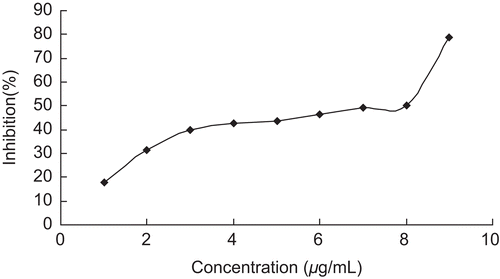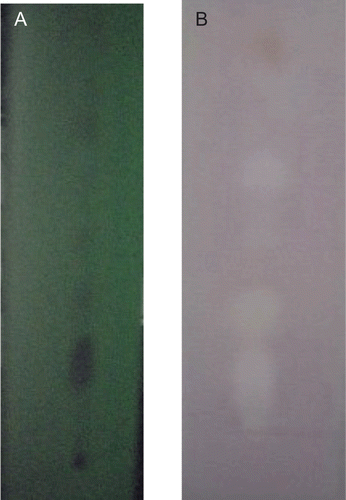Abstract
Context: Helicobacter pylori is a major causative factor in gastritis-like disorders, and urease plays a key role in Helicobacter pylori colonizing and persisting in the mucous layer of the human stomach. In China, a variety of Chinese medicinal herbs have been prescribed to attenuate or eradicate gastritis-like disorders. However, little is known about the urease inhibition of Chinese medicinal herbs.
Objective: The present study was conducted to investigate the urease inhibition activities of the ethanol and water extracts of 15 Chinese medicinal herbs.
Materials and methods: The ethanol and water extracts derived from 15 medicinal herbs, traditionally used for the treatment of gastritis-like disorders in China, were tested for urease-inhibition activity using the phenol red method.
Results: Screened at 10 µg/mL, 14 ethanol extracts and 10 water extracts showed urease inhibition. The ethanol extracts of Magnolia officinalis Rehd. et Wils. (Magnoliaceae) and Cassia obtusifolia L. (Leguminosae) possessed inhibition rates higher than 50% with IC50 values of 6.5 and 12.3 µg/mL, respectively. After fractionating successively, the petroleum ether fraction of the ethanol extracts of Magnolia officinalis showed the best activity with 90.8% urease inhibition at a concentration of 10 µg/mL. The bioautography of the petroleum ether fraction indicated the existence of the urease inhibitors in the herb.
Discussion and conclusion: The present results indicated that some Chinese medicinal herbs might treat gastritis-like disorders via the inhibition of Helicobacter pylori urease and the further possibility for discovering useful novel urease inhibitors from the Chinese medicinal herbs.
Introduction
It was reported that Helicobacter pylori was a major causative factor in gastritis-like disorders and urease played key role in Helicobacter pylori colonizing and persisting in the mucous layer of the human stomach (CitationDunn et al., 1997; CitationKrajewska, 2009). The inhibition of urease is therefore very helpful or crucial for the treatment of Helicobacter pylori infection (CitationAmtul et al., 2002). In recent years, some natural urease inhibitors were isolated form plants (CitationAhmad et al., 2008; CitationArfan et al., 2010; CitationShabana et al., 2010). In China, a variety of Chinese medicinal herbs have been prescribed to attenuate or eradicate gastritis-like disorders. However, little is known about the urease inhibition of Chinese medicinal herbs. To investigate the relationship of the urease inhibitory activities and gastritis-like disorders treatment and to look for novel urease inhibitors, the ethanol and water extracts of 15 Chinese medicinal herbs, traditionally used for the treatment of gastritis-like disorders in China, were tested for urease-inhibition activity.
Materials and methods
Chemicals
Jack bean urease was purchased from Sigma-Aldrich (St. Louis, Missouri, USA). All other reagents used in the study were of analytical grade.
Plant materials and preparation of extracts
The plant materials collected from different parts of China were purchased from the Lianyungang Institute of Traditional Chinese Medicine and Materia Medica, Lianyungang 222006, with each species sorted. The voucher specimens were registered and preserved in the herbarium of Huaihai Institute of Technology, Lianyungang 222005, People’s Republic of China. The botanical and family names, used parts, collection sites, collection time and voucher specimen numbers are presented in .
Table 1. Inhibition of urease by ethanol extracts and water extracts of Chinese medicinal herbs.
Roughly ground air-dried plant materials (40 g, each plant) were extracted twice with 95% ethanol or water (400 mL each) by refluxing for 4 h. The extracts were then filtered, evaporated to dryness in vacuo. As listed in , the yields of extracts were calculated as a percentage amount of solid extract from dried plant material. The residues were redissolved in dimethyl sulfoxide (DMSO) or demineralized water, respectively, to yield a concentration of 100 µg/mL.
A portion of dried ethanol extract of Magnolia officinalis Rehd. et Wils. (Magnoliaceae) was suspended in water and fractionated successively with petroleum ether (40–60°C), chloroform, ethyl acetate and n-butanol. All the fractions were evaporated to dryness in vacuo and also dissolved in DMSO or demineralized water, respectively, to yield a concentration of 100 µg/mL.
Urease inhibition assay
The measurement of urease activities was carried out using an established method (CitationTanaka et al., 2003). The assay mixture, containing 25 µL (4U) of jack bean urease and 25 µL of the test compound, was preincubated for 2 h at room temperature in a 96-well assay plate. After preincubation, 0.2 mL of 100 mmol/L phosphate buffer at pH 6.8, containing 500 mmol/L urea and 0.002% phenol red, was added and the mixture was incubated at 37°C. The reaction time, which was required for enough ammonium carbonate to form to raise the pH of the phosphate buffer from 6.8 to 7.7, was measured at 570 nm using a Synergy HT Multi-Detection Microplate Reader.
Thin-layer chromatography bioautographic assay
Petroleum ether fraction of ethanol extract of Magnolia officinalis was applied to thin-layer chromatography (TLC) plates and developed with chloroform:methanol (200:1, V/V). After air drying, the TLC plate was sprayed with jack bean urease (10 KU/L) uniformly and preincubated for 2 h at room temperature. The plate was then sprayed with 100 mmol/L phosphate buffer at pH 6.8, containing 500 mmol/L urea and 0.002% phenol red, until the silica was saturated with the solvent. After an hour, a red background appeared, with white spots for urease-inhibiting compounds.
Results
In the present study, the ethanol and water extracts derived from 15 Chinese medicinal herbs traditionally used for the treatment of gastritis-like disorders were tested for their urease-inhibition activities. As shown in , 14 ethanol extracts and 10 water extracts possessed detectable urease-inhibition activities at 10 µg/mL. Among them, the ethanol extracts of Magnolia officinalis and Cassia obtusifolia L. (Leguminosae). possessed inhibition rates higher than 50%. The two extracts inhibited urease dose-dependently with IC50 values of 6.5 µg/mL and 12.3 μg/mL, respectively ( and ). Acetohydroxamic acid was taken as the positive control with an IC50 value of 3.12 µg/mL. After the ethanol extract of Magnolia officinalis was fractionated successively with petroleum ether (40–60°C), chloroform, ethyl acetate and n-butanol, the urease-inhibition activities of the fractions were tested. The petroleum ether fraction showed the best urease-inhibiton activity with an inhibition rate of 90.8%, and the urease-inhibitory activities of the fractions decreased with the increasing of the solvent polarity (). The restults showed that the urease inhibitors in the ethanol extract of Magnolia officinalis were low-polarity components. TLC bioautographic assay of the petroleum ether fraction of ethanol extract of Magnolia officinalis showed that there were three urease-inhibition spots in the TLC plate (). The results indicated the existence of urease inhibitors in Magnolia officinalis.
Table 2. Inhibition of urease by ethanol extract and its fractions of Magnolia officinalis Rehd. et Wils.
Discussion and conclusion
Magnolia officinalis and Cassia obtusifolia which possessed potent urease-inhibition activties are well-proven and frequently prescribed herbs for the gastritis-like disorders treatment in the traditional Chinese medical practice. Magnolia officinalis is a herb in Hewei-Decoction, which could eradicate Helicobacter pylori, and the ethanol extract showed remarkable Helicobacter pylori inhibitory activities (CitationJi et al., 2005). The good urease-inhibition activity of the the ethanol extract of Magnolia officinalis further rationalized the utility and efficacy of the Chinese medicinal herb used for the treatment of Helicobacter pylori infection. The ethanol extract of Forsythia suspensa (Thunb.) Vahl (Oleaceae) was reported possessing potent inhibitory activity against urease of Helicobacter pylori and two urease inhibitors (betulinic and oleanolic acids) were isolated from it (CitationShin et al., 2009). In this study, the ethanol extract of Forsythia suspensa showed weaker activity with the inhibition rate of 29.3% than that of the ethanol extract of Magnolia officinalis (inhibition rate: 78.9%). The better urease-inhibition activity of the ethanol extract of Magnolia officinalis than that of Forsythia suspensa holds rich promise in isolating novel potent urease inhibitors from Magnolia officinalis.
The present results indicated that some Chinese medicinal herbs might treat gastritis-like disorders via the inhibition of Helicobacter pylori urease and further the possibility for discovering useful novel urease inhibitors from the Chinese medicinal herbs.
Declaration of interest
The present study was supported by the Natural Science Foundation of Huaihai Institute of Technology (KQ09029) and Natural Science Foundation of Jiangsu Province (BK2009640).
References
- Ahmad M, Muhammad N, Ahmad M, Arif Lodhi M, Jehan N, Khan Z, Ranjit R, Shaheen F, Iqbal Choudhary M. (2008). Urease inhibitor from Datisca cannabina Linn. j Enzyme Inhib Med Chem, 23, 386–390.
- Amtul Z, Rahman AU, Siddiqui RA, Choudhary MI. (2002). Chemistry and mechanism of urease inhibition. Curr Med Chem, 9, 1323–1348.
- Arfan M, Ali M, Ahmad H, Anis I, Khan A, Choudhary MI, Shah MR. (2010). Urease inhibitors from Hypericum oblongifolium WALL. J Enzyme Inhib Med Chem, 25, 296–299.
- Dunn BE, Cohen H, Blaser MJ. (1997). Helicobacter pylori. Clin Microbiol Rev, 10, 720–741.
- Ji WS, Gao ZX, Wu KC, Qiu JW, Shi BL, Fan DM. (2005). Effect of Hewei-Decoction on chronic atrophic gastritis and eradication of Helicobacter pylori. World J Gastroenterol, 11, 986–989.
- Krajewska B. (2009). Ureases I. Functional, catalytic and kinetic properties: A review. J Mol Catal, B Enzym, 59, 9–21.
- Li Y, Xu C, Zhang Q, Liu JY, Tan RX. (2005). In vitro anti-Helicobacter pylori action of 30 Chinese herbal medicines used to treat ulcer diseases. J Ethnopharmacol, 98, 329–333.
- Shabana S, Kawai A, Kai K, Akiyama K, Hayashi H. (2010). Inhibitory activity against urease of quercetin glycosides isolated from Allium cepa and Psidium guajava. Biosci Biotechnol Biochem, 74, 878–880.
- Shin S, Park C, Baek N, Chung I, Park C. (2009). Betulinic and oleanolic acids isolated from Forsythia suspensa Vahl inhibit urease activity of Helicobacter pylori. Bioprocess Biosyst Eng, 14, 140–145.
- Tanaka T, Kawase M, Tani S. (2003). Urease inhibitory activity of simple alpha,beta-unsaturated ketones. Life Sci, 73, 2985–2990.


